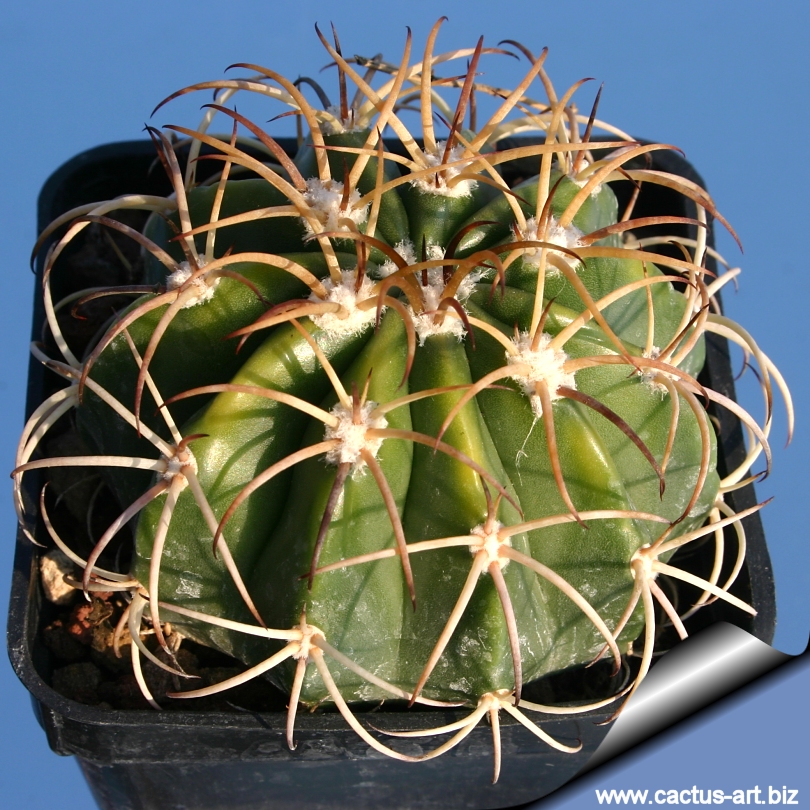|
|
|

Melocactus onycacanthus var.chagualensis KK n.n. Chagual
to Maranon, Peru
It is considered to be one of the most interesting member of the
genus.
|
|
Description: Usually stay
solitary, mature plants are easily recognizable by their cephalium, that
have a covering of wool and orange or red bristles, The immature plant
looks like a smallish barrel cactus, and there is nothing in its
appearance that would suggest a melocactus. M. onychacanthus has
amber arched spines.
Stem: Strongly longitudinally ribbed, globose depresse to
somewhat elongate and pyramidal, shiny dark green, 6-25 cm tall, 8-25 cm
across.
Ribs: 9-12, acute, straight or slightly sinuous.
Areoles: Suncken into notches in the ribs.
Spines: Whitish, amber or reddish (often coated in grey) curved
downward, usually stout.
Central spines: Normally not present or occasionally 1-3,
sometime inconspicuous 1-17 mm long, located in the upper pert of
areoles.
Radial spines: 6 to 12, lower one longer 1 to 25 mm long (of
variable stoutness)
Cephalium: Up to 15 cm tall, 6-10 cm in diameter, with long
reddish bristles and pastel wool.
Flower: Small inconspicuous, pink 18-26 mm long, 5-10 mm in
diameter at the top of the
cephalium.
Blooming season: Spring to summer in mid to late afternoon.
Fruit: Red
clavate15-30 mm long |
|
Advertising
|
|
|
|
|
|
Family:
Cactaceae (Cactus
Family) Melocactus
onychacanthus Ritter
In: Nieuwe vondsten van
cactussen in Peru. Succulenta 45 : 118 1966.
Accepted
Scientific name: Melocactus
bellavistensis ssp. onychacanthus (Ritter) N.P. Taylor 1991
Origin: The variety “onychacanthus” is endemic to a small
area in Amazonas, Balsas, Northern Peru (South America) altitude
800-1800 m.
Conservation status: Listed in
CITES appendix 2.
Common Name: Turk’s cap,” “melon cactus” (or simply
“melon”)
The most remarkable part of a Melocactus is
its
cephalium a bristle-coated structure on the summit of the plant,
only Melocactus, and the similar genus
Discocactus
possesses this type of permanent, apical, hatlike appendage. It’s only
when a Melocactus reaches maturity that the cephalium begins to
grow. Cylindrical, with a diameter distinctly smaller than that of the
plant body below, the cephalium will keep growing for the rest of the
plant’s life, but the body of the plant stops growing the moment the
cephalium starts to form. . As the plants age the cephalium doesn’t
increase in circumference it will steadily grow taller
|
|
|
Cultivation: These cacti
are not the easiest things to grow and aren’t plants for beginners.
Melocactus onychacanthus grows from April to October, it can’t
endure long stretches of total dryness, and also too much water will rot
it, as its weak root systems tends to be inefficient at sucking up water
from wet soil. Nonetheless, again as a result of their tropical origins,
they need a fair amount of water, but allow the soil to dry quite a bit
before watering again. Melocactus rests from October to April but can’t
stand cold, or even fairly cool temperatures, so is indispensable to
keep it above 8-12°C at all times, severe damage or death occurring at
temperatures that the great majority of cacti wouldn’t mind in the least
and prefer more frequent water in winter than other cacti, say once a
month. Do not feed in winter.
The root system is weak and generally resents being repotted and can
take a long time to re-establish. The soil mix should be very quick
draining, prefers very bright light, not as much as the most arid
growing cacti, but plenty nonetheless.
Propagation: Exclusively by
Seeds. Sow in February-march in a light, sandy, porous soil. Cover
germinating tray with glass to prevent seed from drying out. Germination
is most successful at a temperature of 18 to 22° C. |
|

 |
|